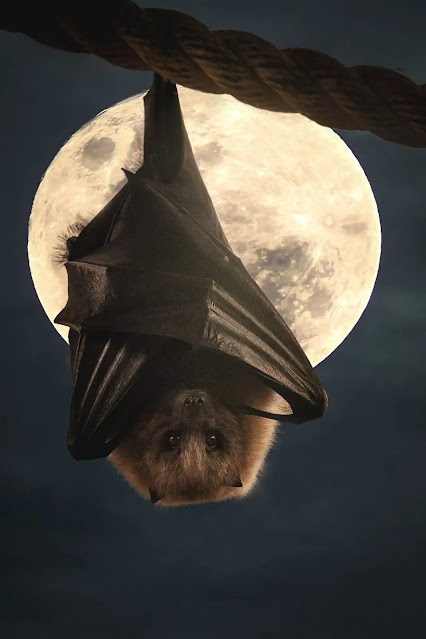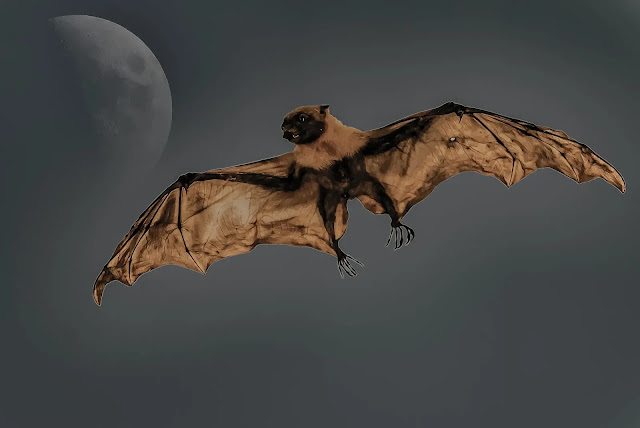How is a bat born?
The Bat
The bat or bat (English: bat) is a small mammal that is
distinguished from other mammals by its ability to fly. The bat belongs to the
order Chiroptera, which in Greek means winged hands; This is because the
structure of the open wing of a bat is similar to the structure of the human
hand, with membranes connecting the four fingers and the thumb remaining free
and not connected to the rest of the fingers.
The bat
uses the free front finger and its hind limbs to attach to trees or caves
upside down; So that his head and body hang down. Bats, like other mammals,
reproduce by giving birth and suckle their young, and their bodies are covered
with hair except for the wings. There are about (1,100) species of bats all
over the world, and they represent nearly one fifth of all mammals.
Types
of bats
Bats are
divided into two main groups:
Megachiroptera
or Megabats :
There are
approximately 170 species of large bats that spread in Asia and Africa, and
large bats do not have to be really large, in fact there are bats that belong
to this group, although they are smaller in size. From some small bats.
Large bats
feed on fruit, pollen, flower nectar, and sometimes insects, and differ from
small bats in that they do not use bio- sonar (echo monitoring) to determine
their direction, except for the Egyptian fruit bat. The largest species of
large bat is the flying fox bat, which weighs 998 g, and the distance between
its wings is 1.5-1.8 m. The smallest species is the long-tongued fruit bat,
which weighs 14 g, and the distance between its wings is 25.4 cm.
Microchiroptera
or microbats:
There are
approximately 800 species of small bats that are spread on all continents
except Antarctica. Most of the small bats feed on insects, a few of them eat
fruit, nectar or small animals, and some drink the blood of large animals.
The largest of
the small bats is the false vampire bat, which weighs between 145-190 g, and
the distance between its wings is one meter, and the smallest bat is the
bumblebee, which weighs 2 g, and the distance between its wings is 3 cm. Small
bats have characteristics that distinguish them from large bats, including:
· It uses bio-sound to determine its
direction.
· It lacks a claw on the second toe on
the front ends.
· Its ears do not form a closed ring,
but the tips are separated from each other at the base of the ear.
· It lacks undercoat, but it has
protective hair, and it can be bare.
Bat
multiplication
The method of bat
reproduction varies according to the species to which it belongs and the
environment in which it lives. In general, the available information on bat
reproduction methods is limited; Due to its diversity and spread; This makes
studying it difficult. Some female bats go through the estrous cycle (the
period during which they show their readiness to mate) once or twice a year,
and some females have multiple estrous cycles.
Male bats
flirt with females in several ways, including: singing, spreading and
displaying wings, and extending the long hair that is located on the top of the
head. Mating occurs in North American bats, northern Eurasia and horseshoe bats
in the fall, then they hibernate for the winter, and the female stores the
sperm inside her reproductive system until the coming of spring and the start
of the warm season and the presence of abundance of food, then the female
awakens and ovulation occurs and ovulation occurs. ; This is to increase the
chances of young children to grow and survive.
The length of
the gestation period for a female bat depends on the environment in which the
female lives and its temperature, for example, the gestation period of a paper
nose bat is three months, and the gestation period of a female flying fox is
between 5-6 months, and more than five months in a vampire bat.
The female
nocturnal bat has a gestation period of 6-14 weeks. In some species, pregnant
females migrate when their due date approaches to special settlements (nursery)
that are warmer, and include only pregnant females, and do not receive males or
non-pregnant females. The female gives birth hanging from her feet, and holds
the newborn by her wing to prevent it from falling to the ground.
Most bats give birth to one young, and some,
such as the female large brown bat, may give birth to twins, and some may give
birth between 1-4 young, such as the eastern red bat, and some females can
conceive twice in one year.
Baby bats are born blind, deaf, and hairless, and the birth
weight is between one-sixth to one-third of the mother's weight; That is,
between 0.22-370 grams, and the hind legs are well developed, and the young use
them to attach to the mother or the roost, and the wings are not fully
developed.
Females breastfeed their young from the
mammary glands that are found in the chest area in some species, or in the
underarm area in other species, and some species have false nipples for the
young to attach to his mouth during the mother’s flight. The young are weaned
often after five or six weeks in types Baby bats, and five months in an Indian
flying fox.
Mothers leave the nursery in search of food,
and may carry their young with them for a short period of time, but most of the
young are left hanging on the wall or ceiling of the nursery, and when the
mother returns, she is able to distinguish her young from among the millions of
similar-shaped bats; Through their sounds, their smell and their recollection
of where you left them.
The young
reach the age of sexual maturity in the first or second year of life, but it is
known that the mortality of young bats is high compared to adults; Because of
falling from ceilings or being injured during their first attempts to fly, in
addition to diseases and disorders caused by genetic mutations.
The
importance of bats
Bats are of great importance in human
life, including:
· Many tropical and semi-tropical
plants and trees are pollinated, such as: figs, avocados, bananas, breadfruit,
mangoes, peaches, and dates.
· Devouring large numbers of insects,
each bat eats about half its weight in insects; Which helps to control large
numbers of pests that damage crops and reduce the spread of diseases.
· Manure is produced rich in
phosphorous and nitrogen, which is used as a natural fertilizer in many
countries in the world.
· Bat dung covers artifacts and
fossils in caves; This helps to preserve it.
· Some species of bats, such as flying
foxes, are a source of food in some parts of Southeast Asia, and some Pacific
islands.
· Bats are of great importance for
scientific research purposes; Where some physiological aspects of bats are
studied, such as: long-distance migration, hibernation, complex temperature
regulation, and induction of direction using sound.
On the
other hand, bats have some disadvantages, such as:
· Vampire bats inflict small wounds on
livestock in some parts of tropical America, and these wounds are ideal sites
for parasites to lay their eggs.
· The vampire bat transmits rabies and
trypanosomiasis to livestock.
· Large colonies of bats that inhabit
homes and public buildings in the tropics are disturbing with their sounds,
smells, and droppings.






